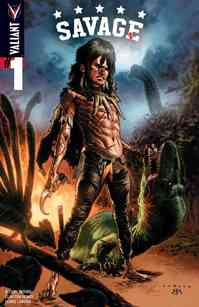B. Clay Moore on Surviving a Savage Landscape (with a Side of Soccer)
Main Art by Renato Guedes Comics Features B. Clay Moore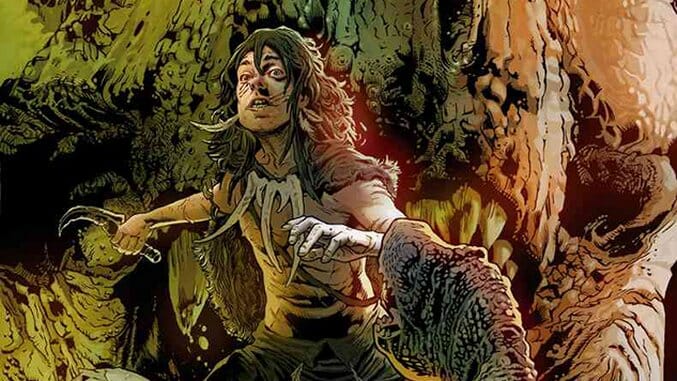
The first issue of the new Valiant comic Savage, written by B. Clay Moore, opens with a scene that’s literally the stuff of primal pulp: a young man in a densely arboreal landscape battles with a dinosaur. The setting is lush, the action is visceral and from both, a mystery emerges: who is this character, and what, exactly, is he doing fighting dinosaurs? In a parallel story set 14 years earlier, the reader meets a celebrity couple, Kevin and Veronica Sauvage—one known for his skills as a soccer player, the other a business-savvy former model—traveling with their infant son. Their plane crash-lands near an island, where they seek refuge.
Art duties are split between Lewis LaRosa, who handles the contemporary story, and Clayton Henry, who illustrates the flashbacks. The division allows for a sharp aesthetic contrast, with LaRosa’s art abounding with atmosphere and Henry’s providing a rich sense of the characters’ body language and personal dynamics. Moore’s script is as equally comfortable using dialogue to express character as it is to rely entirely on action to move the story forward. Paste talked with Moore about a host of topics: the enduring appeal of “lost worlds,” the way several of his books have examined the nature of celebrity and the way he worked his passion for soccer into this book. A four-issue miniseries, Savage debuts in November. ![]()
Paste: The concept of someone from modern society being lost in a mysterious, primal world is one that’s endured for decades, if not longer. What accounts for the continuing popularity of this scenario?
B. Clay Moore: There’s obviously something inherent in human nature that drives us to seek the unexplored. The entire history of human migration is based on that quest to explore the unknown. Combine that with our constant obsession with the “current” state of mankind, and it’s only natural that people are curious to see how “modern” life (relative to a story’s date) has prepared us, or left us unprepared, to face these more primal environments.
And, of course, there’s the Walter Mitty aspect of daydreaming your way out of whatever banal existence you might feel trapped in. As a kid, I fell in love with Edgar Rice Burroughs’ John Carter of Mars novels, and that probably planted the seeds that ultimately led me to Savage.
Paste: What first drew you to that concept? And how did you go about finding your own—pardon the possible soccer pun—spin on it?
Moore: One of the things I enjoy doing is tweaking traditional genres, and I hadn’t really done much in this vein before. While considering the notion that most “primal” characters have one-word names, the idea that one of those names might have existed first as a nickname came to mind.
For whatever reason, that reminded me of international soccer/football stars, who are often known by a single name. “Savage” seemed a natural, colorful shorthand for “Sauvage,” and the rest fell into place. I also think there are few more glamorous professions than that of an international soccer star, so the idea of dropping a pampered footballer into this scenario was appealing.
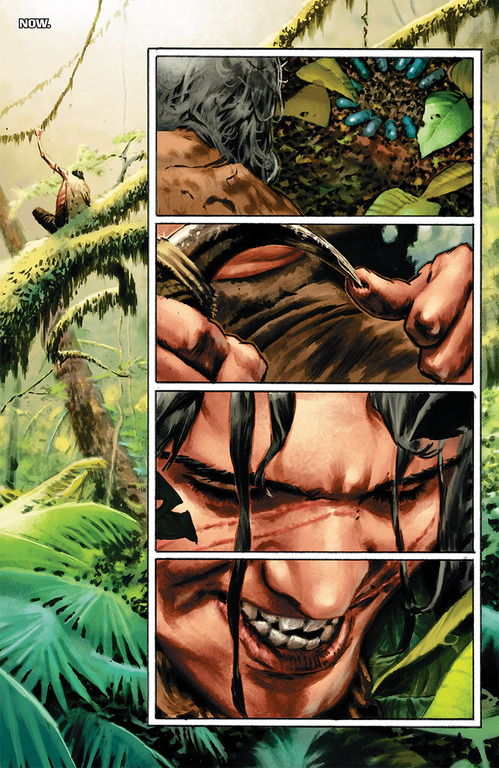
Savage Interior Art by Lewis LaRosa
Paste: The artwork in Savage has very different styles for the present-day and flashback sequences. How far into the process did this narrative approach arise as the best one to use for this story?
Moore: Lewis LaRosa and Clayton Henry came onto the book together. On top of being a monster talent, Lewis is a dinosaur fanatic, and a genuine expert on the subject, so he was a natural for the more “feral” moments in the book. You will not read a comic book with more accurate depictions of dinosaurs. I can pretty much guarantee that. Clayton is an exceptional storyteller, and an artist who’s at the top of his game right now, and he really brings the Sauvages to life as they plunge into this strange new world. None of which would matter if colorist Brian Reber wasn’t operating completely in sync with both artists. It’s a great looking book.
Paste: The main character’s parents seem to be modeled pretty closely on David and Victoria Beckham, and their celebrity is something that informs a lot of the flashbacks in the first issue. You’ve also dealt with questions of celebrities in the past, in books like The Leading Man—what attracts you to juxtaposing public figures with different genre elements?
Moore: I find the way people perceive celebrities to be interesting. One of the generally accepted concepts I have the most trouble wrapping my brain around is that if someone is rich and/or famous, they’re not entitled to suffer or complain about their lives (or anything else, it sometimes seems). We spend so much time insisting that there’s more to life than money, but at the same time we expect people with money and fame to be perfectly content regardless of anything, and our sympathy for them vanishes.
I suppose throwing public figures into extreme situations is interesting to me because it challenges perceptions of these people, and, if the story is handled properly, forces the characters to re-examine their own self-perceptions. In the case of Savage, we’re dealing with people who fought hard to not have to fight any more. What happens when the only way they can survive, or save their son, is to fight harder than ever?
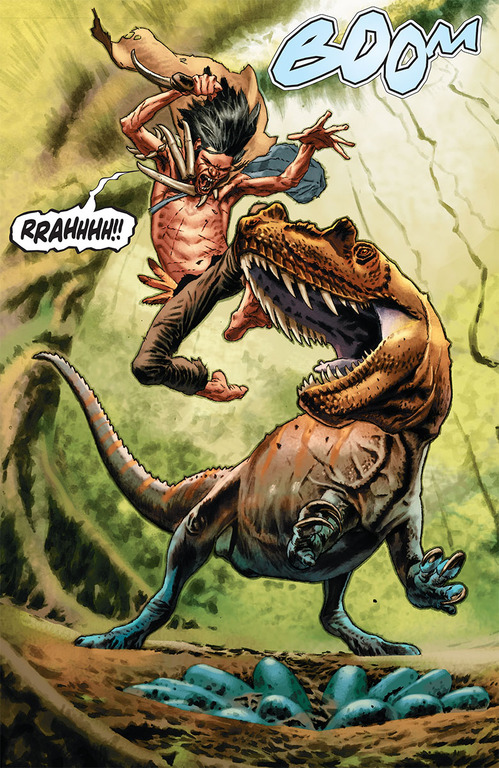
Savage Interior Art by Lewis LaRosa
Paste: Do you find that writing a comic set closer to the present day, such as Savage, is more challenging than a period piece like Hawaiian Dick or the JSA work you’ve done for DC?
Moore: Not especially. I’ve written stories in so many different eras and genres, there’s not one I feel especially comfortable in compared to another. When I write period stories, my goal is to play against our perceptions of previous eras, rather than document those eras in accurate detail. That works just as well when writing contemporary stories, I think. The only thing a writer has to do when telling a story set in any era or environment is fake it well enough to make it seem believable.
Paste: How much backstory for the Sauvages did you need to come up with before you started working on the issue? And did the Dennis Bergkamp reference in the dialogue stump anyone?
Moore: One of the early drafts actually spent more time tracing the history of the Sauvages. In the end, it was probably extraneous and didn’t add much to the reading experience, but it always helps when you’ve fully fleshed out a character’s background. In my head, I know that Kevin Sauvage grew up poor on the streets of France before being plucked off the streets by a British football scout. I know that Veronica was raised by wealth in England, and that she saw potential in the young Kevin Sauvage long before he made much of an impact on the soccer pitch.
All of that informs the way I handle their relationship, and the way they respond to their environment. As for Bergkamp, I’m an Arsenal fan. What can I say?
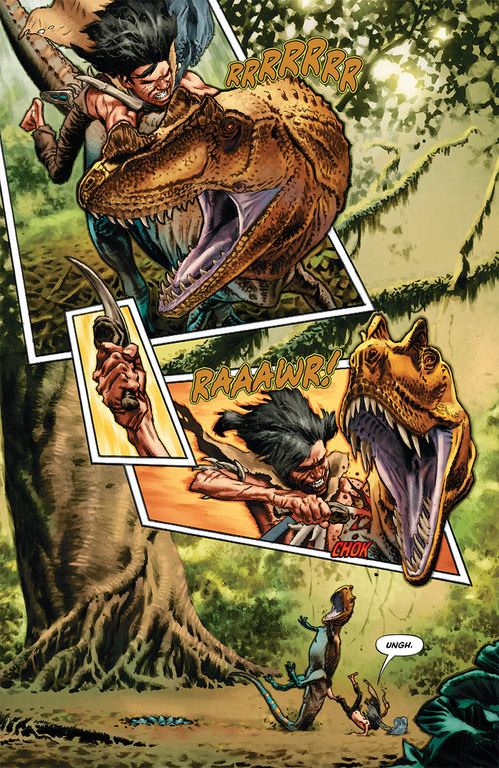
Savage Interior Art by Lewis LaRosa
Paste: You’ve worked on books that have been open-ended, finite and established as a kind of series of mini-series (Hawaiian Dick, most famously). What appeals to you about each? Is Savage designed to be self-contained, or do you see yourself exploring other aspects of this concept in the future?
Moore: The series of mini-series model is probably the most practical way to handle an original creator-owned concept. It takes some of the weight off the creative team and allows some breathing room between arcs. I tend to look at each issue in a series as a story within a story. In a sense, that’s what a series of mini-series amounts to: stories within a larger story.
I see Savage as a way to establish the character in the Valiant Universe, and as a way to define him for readers. I’d love to pick up the threads we drop here and continue to examine the character and how he interacts and responds to the world around him. After all, the only way to truly make a character’s story “finite” is to kill him or her at the end. I suppose I should have used a spoiler alert there. Let’s just say he probably survives this initial story.

Savage Interior Art by Lewis LaRosa
Paste: Stylistically, you’ve written stories set in a number of genres — are there any that you’d like to work in that you haven’t already?
Moore: I’d like to do something horror-related before too long. That’s a pretty broad genre, but that’s one of the reasons it appeals to me. I’m a big fan of Westerns, but I think you really need to find the right hook to make Westerns work in comics. What I enjoy doing the most is finding a unique spin to put on existing genres. I suppose I feel like the spin is more important than the genre.
One thing I’ve never done that I’d like to do is handle a long, uninterrupted run on a single title, whether it’s directing an existing book or creating a new ongoing book of my own with a long run in mind. I just need to find the right opportunity.
